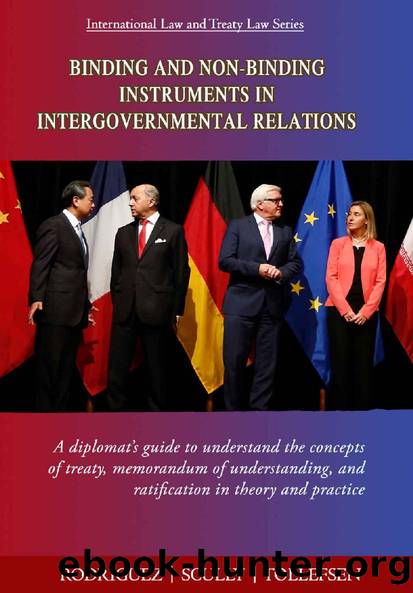Binding and Non-Binding Instruments in Intergovernmental Relations: A diplomat’s guide to understand the concepts of treaty, memorandum of understanding, ... Law and Treaty Law Series Book 1) by Roberto Rodriguez & Mark Scully & John Tollefsen

Author:Roberto Rodriguez & Mark Scully & John Tollefsen [Rodriguez, Roberto]
Language: eng
Format: epub
Publisher: EUCLID University Press
Published: 2015-07-22T00:00:00+00:00
[117] (1995-1999) only mentions two instances where registration was declined, and it may be hoped that the forthcoming volume will include a detailed review of every such decision.
UNDERSTANDING RATIFICATION AND SIGNATURE
A. Another confusing term
Our main concern so far has been the confusion surrounding the word “treaty,” especially as distinguished from “MOU.”
Hopefully, we have been successful in our explanation that the expressions “binding and registrable agreement” (BRA) and “non-binding instruments” (NBI) are preferable. We have also shown that BRAs can be in solemn form (the word “treaty” is best used in this case) or in simplified form (still treaties in the sense of the Vienna Convention but not always in the sense of constitutional definitions).
We are now ready to deal with another confusing term: “ratify,” and with it “ratification.” Most people, including many diplomats, think that “to ratify” (a treaty) means that the parliament (or whatever it is called in their national system) has to approve what the executive branch has done. But “to ratify,” for the purposes of the Vienna Convention on the Law of Treaties, has in fact nothing to do with subsequent parliamentary approval.
One way to explore this curiosity is to return to our imaginary discussion in the Oval Office. You, the President of the United States no less, are still reviewing the documents you are supposed to sign with the help of your amazingly competent aide (whose imaginary name is Erin Scully and who happens to be a EUCLID LLM graduate).
“Here is that Space Launch Emergency Landing Framework Agreement that has been on my desk for a while,” you comment. “Who else is in that?”
“It’s a closed multilateral, only for us, Gambia, Saint Vincent and the Grenadines, and Russia,” Erin explains, “it enters into force according to the terms of Article 10 you see, when all four parties have ratified.”
Just to be sure, you ask “that’s a treaty right?”
“Yes sir. Framework Agreement is a title sometimes used for these kinds of treaties.” Erin’s answer is, for a change, direct and unequivocal.
“OK, does this one have to go the Senate for consent?” You know that you are dealing with a BRA, but your question really means: “OK, so this is treaty under the broad definition of customary international law, but is it is treaty in the sense of Article II of the US Constitution?”
“Yes sir! The Senate Committee on Foreign Relations has made it clear that there is a lot more in there than meets the eyes, including national security concerns. But there is consensus that we should get our 67 votes on that.”
“So I can sign today and they get to ratify it?” you summarize as you get your pen ready.
“It depends on what you mean by ‘ratify’ says your aide. “The US Constitution uses the verb ‘ratify’ about Articles, not treaties. So I would say that ‘ratify’ refers to a subsequent process to validate a preexisting action. But I should also say that ‘ratify’ is used in a slightly different in the Vienna Convention.”
“You means like the word ‘treaty’ does?” you offer.
Download
This site does not store any files on its server. We only index and link to content provided by other sites. Please contact the content providers to delete copyright contents if any and email us, we'll remove relevant links or contents immediately.
The Pirates of Somalia by Jay Bahadur(1587)
Political Theology by Carl Schmitt(1545)
The Holocaust: A New History by Laurence Rees(1488)
The Social Animal by David Brooks(1411)
A Practical Guide to International Arbitration in London by Hilary Heilbron(1396)
Restitution by Restitution(1394)
Pirates of Somalia by Jay Bahadur(1348)
Coercing Virtue by Robert H. Bork(1325)
The Nuremberg Interviews by Leon Goldensohn(1274)
Basic International Corporate Taxation by Sebastiano Garufi(1179)
A History Of Thailand by Baker Chris(1153)
International Trade and Business: Law, Policy and Ethics by Gabriël Moens & Peter Gillies(1109)
The Global Commons by Susan J. Buck(1106)
Asian Waters by Humphrey Hawksley(1094)
Blood Profits by Vanessa Neumann(1089)
The Sovereignty of Human Rights by Macklem Patrick(1076)
Spring Fever: The Illusion of Islamic Democracy by McCarthy Andrew C(1076)
The Nuremberg Trials: The Nazis and their Crimes Against Humanity by Roland Paul(1022)
Crimes Against Humanity: Historical Evolution and Contemporary Application by M. Cherif Bassiouni(997)
